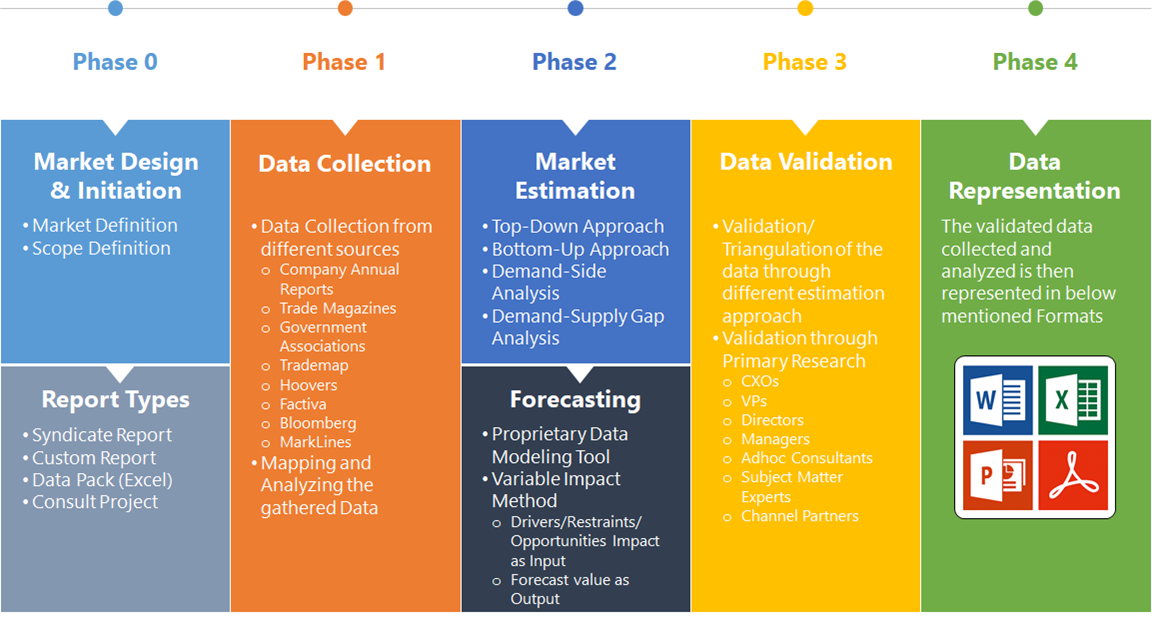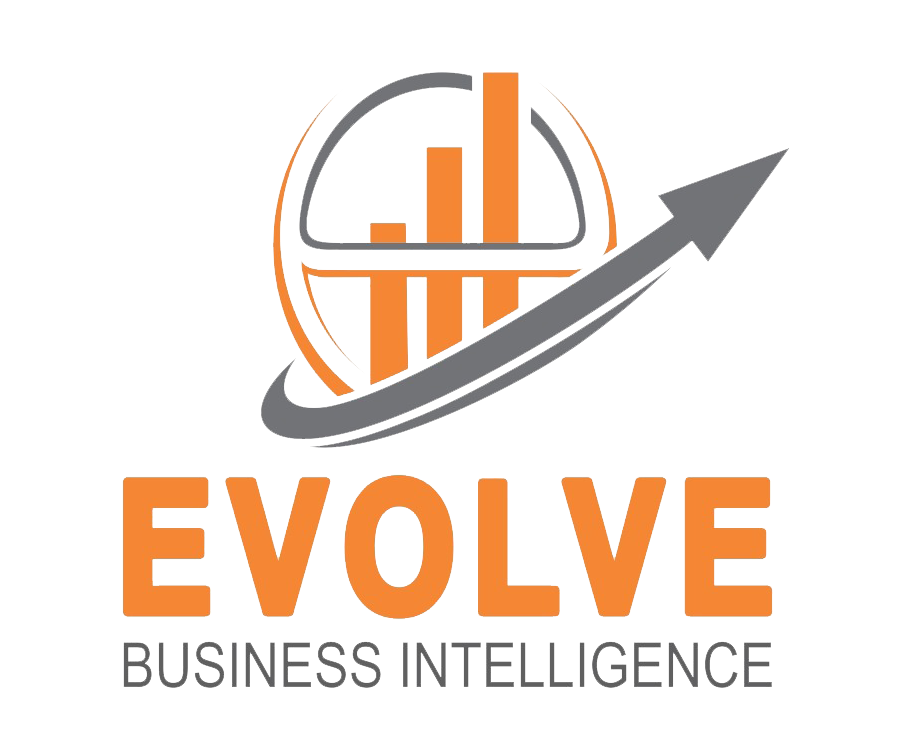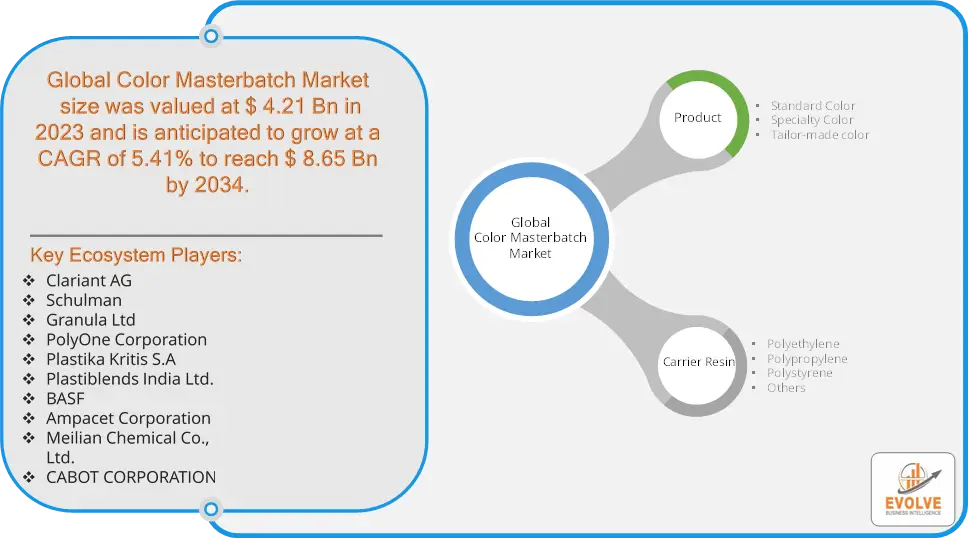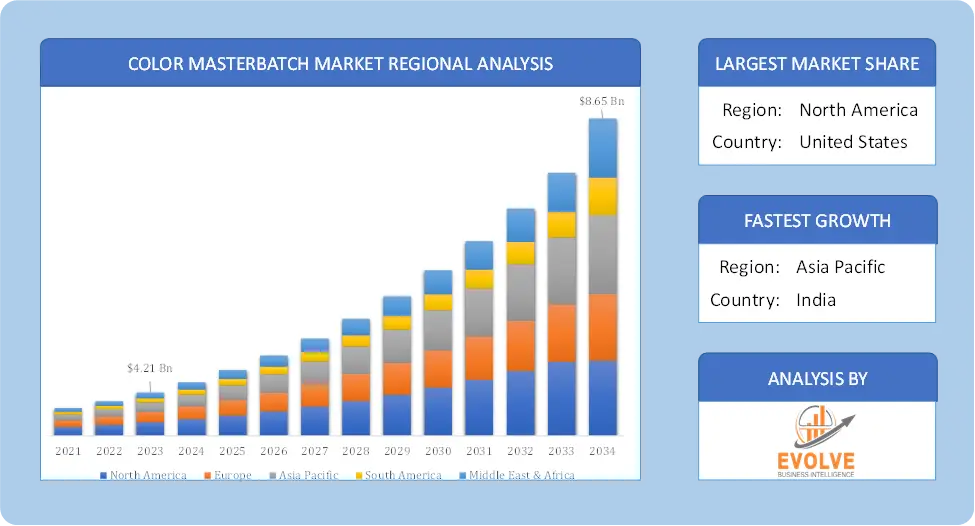Color Masterbatch Market Analysis and Global Forecast 2021-2034
$ 1,390.00 – $ 5,520.00Price range: $ 1,390.00 through $ 5,520.00
Color Masterbatch Market Research Report: Information By Product Type (Standard Color, Specialty Color, Tailor-made color), By Carrier Resin (Polyethylene, Polypropylene, Polystyrene, Others ), and by Region — Forecast till 2034
Page: 130
Color Masterbatch Market Overview
The Color Masterbatch Market Size is expected to reach USD 8.65 Billion by 2034. The Color Masterbatch Market industry size accounted for USD 4.21 Billion in 2023 and is expected to expand at a compound annual growth rate (CAGR) of 5.41% from 2021 to 2034. The Color Masterbatch Market refers to the industry focused on the production and distribution of concentrated mixtures of pigments or additives encapsulated in a carrier resin, which are used to color or enhance the properties of plastic products. These masterbatches offer an efficient and cost-effective way to introduce colors or specific properties into plastics during the manufacturing process. The market is driven by the growing demand for plastic products in various sectors such as packaging, automotive, consumer goods, and construction. Technological advancements in polymer production and the rising trend of customized plastic products are also contributing to the market’s growth.
Global Color Masterbatch Market Synopsis
The COVID-19 pandemic has led to supply chain disruptions leading to supply shortages or lower demand in the Color Masterbatch market. The travel restrictions and social-distancing measures have resulted in a sharp drop in consumer and business spending and this pattern is to continue for some time. The end-user trend and preferences have changed due to the pandemic and have resulted in manufacturers, developers, and service providers to adopt various strategies to stabilize the company.
Color Masterbatch Market Dynamics
The major factors that have impacted the growth of Color Masterbatch are as follows:
Drivers:
Ø Technological Advancements
Continuous advancements in polymer and pigment technologies have led to the development of more efficient and high-performance color masterbatches. Innovations such as biodegradable masterbatches, advanced dispersion technologies, and environmentally friendly formulations are gaining traction, catering to the growing demand for sustainable and eco-friendly products.
Restraint:
- Competition from Alternative Coloring Methods
The market faces competition from alternative methods of coloring plastics, such as liquid colorants and pre-colored resins. While color masterbatches offer several advantages, including ease of use and customization, some industries may prefer liquid colorants for their lower initial costs, better dispersion properties, and suitability for small batch productions. This competition can limit the market share of color masterbatches in certain applications.
Opportunity:
⮚ Advancements in High-Performance Masterbatches
The demand for high-performance plastics in industries such as automotive, aerospace, electronics, and healthcare is on the rise. This presents an opportunity for the development of color masterbatches that not only provide aesthetic value but also enhance the functional properties of plastics, such as UV resistance, thermal stability, and conductivity. Masterbatches that offer multiple functionalities, including color and performance enhancements, are likely to see increased demand in these high-value sectors.
Color Masterbatch Segment Overview
By Product
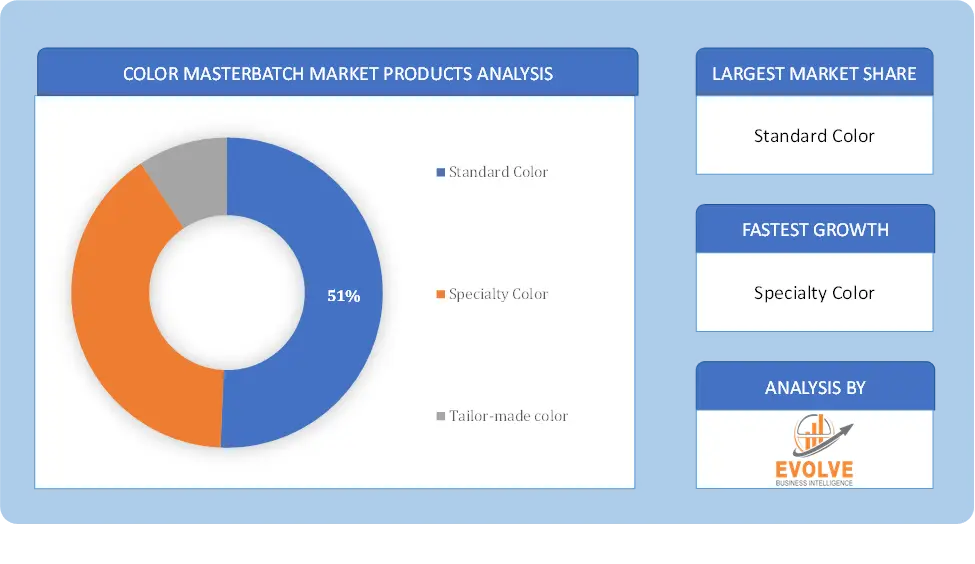 Based on Product, the market is segmented based on Standard Color, Specialty Color, Tailor-made color. the Standard Color segment usually dominates, as it is widely used across various industries due to its cost-effectiveness and availability in commonly required colors, making it a go-to choice for large-scale applications.
Based on Product, the market is segmented based on Standard Color, Specialty Color, Tailor-made color. the Standard Color segment usually dominates, as it is widely used across various industries due to its cost-effectiveness and availability in commonly required colors, making it a go-to choice for large-scale applications.
By Carrier Resin
Based on Carrier Resins, the market has been divided into the Polyethylene, Polypropylene, Polystyrene, Others. the Polypropylene (PP) segment typically dominates, due to its widespread use in packaging, automotive parts, and consumer goods, where its excellent chemical resistance and flexibility make it the preferred carrier resin.
Global Color Masterbatch Market Regional Analysis
Based on region, the global Color Masterbatch market has been divided into North America, Europe, Asia-Pacific, the Middle East & Africa, and Latin America. North America is projected to dominate the use of the Color Masterbatch market followed by the Asia-Pacific and Europe regions.
 Color Masterbatch North America Market
Color Masterbatch North America Market
North America holds a dominant position in the Color Masterbatch Market. In 2022, the Color Masterbatch Market in North America held a 45.80% market share. The area benefits from a robust consumer goods market, a well-established packaging industry, and a booming automotive sector. Furthermore, the market for color masterbatch in the United States had the most market share, while the market for armor materials in Canada had the quickest rate of growth in the North American area.
Color Masterbatch Asia-Pacific Market
The Asia-Pacific region has indeed emerged as the fastest-growing market for the Color Masterbatch industry. A faster compound annual growth rate (CAGR) is anticipated in the Asia-Pacific Color Masterbatch Market from 2021 to 2032. The packaging business is flourishing, the consumer products sector is expanding, and the region’s infrastructure development is speeding up. In addition, the Color Masterbatch market in China had the most market share, while the Color Masterbatch market in India had the quickest rate of growth in the Asia-Pacific area.
Competitive Landscape
The global Color Masterbatch market is highly competitive, with numerous players offering a wide range of software solutions. The competitive landscape is characterized by the presence of established companies, as well as emerging startups and niche players. To increase their market position and attract a wide consumer base, the businesses are employing various strategies, such as product launches, and strategic alliances.
Prominent Players:
- Clariant AG
- Schulman
- Granula Ltd
- PolyOne Corporation
- Plastika Kritis S.A
- Plastiblends India Ltd.
- BASF
- Ampacet Corporation
- Meilian Chemical Co., Ltd.
- CABOT CORPORATION.
Key Development
December 2019 –It was recently revealed that Clariant Color and Masterbatch Additives Company has been bought by PolyOne Corporation, a top producer of specialized polymer goods, services, and solutions. Both businesses concentrate on providing specialized products and services for rapidly expanding international end markets like packaging, fashion, and healthcare.
Scope of the Report
Global Color Masterbatch Market, by Product
- Standard Color
- Specialty Color
- Tailor-made color
Global Color Masterbatch Market, by Carrier Resin
- Polyethylene
- Polypropylene
- Polystyrene
- Others
Global Color Masterbatch Market, by Region
- North America
- US
- Canada
- Mexico
- Europe
- UK
- Germany
- France
- Italy
- Spain
- Benelux
- Nordic
- Rest of Europe
- Asia Pacific
- China
- Japan
- South Korea
- Indonesia
- Austalia
- Malaysia
- India
- Rest of Asia Pacific
- South America
- Brazil
- Argentina
- Rest of South America
- Middle East & Africa
- Saudi Arabia
- UAE
- Egypt
- South Africa
- Rest of Middle East & Africa
| Parameters | Indicators |
|---|---|
| Market Size | 2033: $8.65 Billion |
| CAGR | 5.41% CAGR (2023-2033) |
| Base year | 2022 |
| Forecast Period | 2023-2033 |
| Historical Data | 2021 |
| Report Coverage | Revenue Forecast, Competitive Landscape, Growth Factors, and Trends |
| Key Segmentations | Product Type, Carrier Resin |
| Geographies Covered | North America, Europe, Asia-Pacific, Latin America, Middle East, Africa |
| Key Vendors | Clariant AG, Schulman, Granula Ltd, PolyOne Corporation, Plastika Kritis S.A, Plastiblends India Ltd., BASF, Ampacet Corporation, Meilian Chemical Co., Ltd., CABOT CORPORATION. |
| Key Market Opportunities | • Growing Customization Demand and Developments in Color Technology |
| Key Market Drivers | • Demand for plastic products is rising, as are regulatory compliance and sustainability concerns. |
REPORT CONTENT BRIEF:
- High-level analysis of the current and future Color Masterbatch market trends and opportunities
- Detailed analysis of current market drivers, restraining factors, and opportunities in the future
- Color Masterbatch market historical market size for the year 2022, and forecast from 2021 to 2034
- Color Masterbatch market share analysis at each product level
- Competitor analysis with detailed insight into its product segment, Government & Defense strength, and strategies adopted.
- Identifies key strategies adopted including product launches and developments, mergers and acquisitions, joint ventures, collaborations, and partnerships as well as funding taken and investment done, among others.
- To identify and understand the various factors involved in the global Color Masterbatch market affected by the pandemic
- To provide a detailed insight into the major companies operating in the market. The profiling will include the Government & Defense health of the company’s past 2-3 years with segmental and regional revenue breakup, product offering, recent developments, SWOT analysis, and key strategies.
Press Release

Global Pharmaceutical Manufacturing Market to Reach $1.38 Trillion by 2035 with 7.35% CAGR, New Research Shows

The Global Mammography Market Is Estimated To Record a CAGR of Around 10.29% During The Forecast Period

Glue Stick Market to Reach USD 2.35 Billion by 2034

Podiatry Service Market to Reach USD 11.88 Billion by 2034

Microfluidics Technology Market to Reach USD 32.58 Billion by 2034

Ferric Chloride Market to Reach USD 10.65 Billion by 2034

Family Practice EMR Software Market to Reach USD 21.52 Billion by 2034

Electric Hairbrush Market to Reach USD 15.95 Billion by 2034

Daily Bamboo Products Market to Reach USD 143.52 Billion by 2034

Cross-border E-commerce Logistics Market to Reach USD 112.65 Billion by 2034
Frequently Asked Questions (FAQ)
What is the study period of this market?
The study period of the global Clean Label Ingredients market is 2021- 2034
What are the 10 Years CAGR (2021 to 2034) of the global Clean Label Ingredients market?
The global Clean Label Ingredients market is growing at a CAGR of ~5.74% over the next 10 years
Which region has the highest growth rate in the market of Clean Label Ingredients?
Asia Pacific is expected to register the highest CAGR during 2021-2034
Which region accounted for the largest share of the market of Clean Label Ingredients?
Europe holds the largest share in 2023
Major Key Players in the Market of Stem Cell Manufacturers?
Cargill Inc, Archer Daniels Midland, CORBION, Kerry Group PLC, Ingredion Incorporated, Tate & Lyle, Sensient technologies, Frutarom, Koninklijke DSM N.V, Chr Hasen A/S, Dupont
Do you offer Post Sale Support?
Yes, we offer 16 hours of analyst support to solve the queries
Do you deliver sections of a report?
Yes, we do provide regional as well as country-level reports. Other than this we also provide a sectional report. Please get in contact with our sales representatives
Table of Content
Chapter 1. Executive Summary Chapter 2. Scope of The Study 2.1. Market Definition 2.2. Scope of The Study 2.2.1. Objectives of Report Chapter 3. Evolve BI Methodology Chapter 4. Market Insights and Trends 4.1. Supply/ Value Chain Analysis 4.2. Porter’s Five Forces Analysis 4.2.1. Threat of New Entrants 4.2.2. Bargaining Power of Buyers 4.2.3. Bargaining Power of Suppliers 4.2.4. Threat of Substitutes 4.2.5. Industry Rivalry 4.3. Impact of COVID-19 on Color Masterbatch Market 4.3.1. Impact on Market Size 4.3.2. End User Trend, Preferences and Budget Impact 4.3.3. Regulatory Framework/Government Policies 4.3.4. Key Players Strategy to Tackle Negative Impact 4.3.5. Opportunity Window Chapter 5. Market Dynamics 5.1. Introduction 5.2. DRO Analysis 5.2.1. Drivers 5.2.2. Restraints 5.2.3. Opportunities Chapter 6. Global Color Masterbatch Market, By Product Type 6.1. Introduction 6.2. Standard Color 6.3. Specialty Color 6.4. Tailor-made color Chapter 7. Global Color Masterbatch Market, By Carrier Resin 7.1. Introduction 7.2. Polyethylene 7.3. Polypropylene 7.4. Polystyrene 7.5. Others Chapter 8. Global Color Masterbatch Market, By Region 8.1. Introduction 8.2. North America 8.2.1. Introduction 8.2.2. Driving Factors, Opportunity Analyzed and Key Trends 8.2.3. Market Size and Forecast, By Country, 2020 - 2028 8.2.4. Market Size and Forecast, By Product Type, 2020 - 2028 8.2.5. Market Size and Forecast, By Carrier Resin, 2020 – 2026 8.2.6. US 8.2.6.1. Introduction 8.2.6.2. Driving Factors, Opportunity Analyzed and Key Trends 8.2.6.3. Market Size and Forecast, By Product Type, 2020 - 2028 8.2.6.4. Market Size and Forecast, By Carrier Resin, 2020 - 2028 8.2.7. Canada 8.2.7.1. Introduction 8.2.7.2. Driving Factors, Opportunity Analyzed and Key Trends 8.2.7.3. Market Size and Forecast, By Product Type, 2020 - 2028 8.2.7.4. Market Size and Forecast, By Carrier Resin, 2020 - 2028 8.3. Europe 8.3.1. Introduction 8.3.2. Driving Factors, Opportunity Analyzed and Key Trends 8.3.3. Market Size and Forecast, By Country, 2020 - 2028 8.3.4. Market Size and Forecast, By Product Type, 2020 - 2028 8.3.5. Market Size and Forecast, By Carrier Resin, 2020 – 2026 8.3.6. Germany 8.3.6.1. Introduction 8.3.6.2. Driving Factors, Opportunity Analyzed and Key Trends 8.3.6.3. Market Size and Forecast, By Product Type, 2020 - 2028 8.3.6.4. Market Size and Forecast, By Carrier Resin, 2020 - 2028 8.3.7. France 8.3.7.1. Introduction 8.3.7.2. Driving Factors, Opportunity Analyzed and Key Trends 8.3.7.3. Market Size and Forecast, By Product Type, 2020 - 2028 8.3.7.4. Market Size and Forecast, By Carrier Resin, 2020 - 2028 8.3.8. UK 8.3.8.1. Introduction 8.3.8.2. Driving Factors, Opportunity Analyzed and Key Trends 8.3.8.3. Market Size and Forecast, By Product Type, 2020 - 2028 8.3.8.4. Market Size and Forecast, By Carrier Resin, 2020 - 2028 8.3.9. Italy 8.3.9.1. Introduction 8.3.9.2. Driving Factors, Opportunity Analyzed and Key Trends 8.3.9.3. Market Size and Forecast, By Product Type, 2020 - 2028 8.3.9.4. Market Size and Forecast, By Carrier Resin, 2020 - 2028 8.3.10. Rest of Europe 8.3.10.1. Introduction 8.3.10.2. Driving Factors, Opportunity Analyzed and Key Trends 8.3.10.3. Market Size and Forecast, By Product Type, 2020 - 2028 8.3.10.4. Market Size and Forecast, By Carrier Resin, 2020 - 2028 8.4. Asia-Pacific 8.4.1. Introduction 8.4.2. Driving Factors, Opportunity Analyzed and Key Trends 8.4.3. Market Size and Forecast, By Country, 2020 - 2028 8.4.4. Market Size and Forecast, By Product Type, 2020 - 2028 8.4.5. Market Size and Forecast, By Carrier Resin, 2020 - 2028 8.4.6. China 8.4.6.1. Introduction 8.4.6.2. Driving Factors, Opportunity Analyzed and Key Trends 8.4.6.3. Market Size and Forecast, By Product Type, 2020 - 2028 8.4.6.4. Market Size and Forecast, By Carrier Resin, 2020 - 2028 8.4.7. India 8.4.7.1. Introduction 8.4.7.2. Driving Factors, Opportunity Analyzed and Key Trends 8.4.7.3. Market Size and Forecast, By Product Type, 2020 - 2028 8.4.7.4. Market Size and Forecast, By Carrier Resin, 2020 - 2028 8.4.8. Japan 8.4.8.1. Introduction 8.4.8.2. Driving Factors, Opportunity Analyzed and Key Trends 8.4.8.3. Market Size and Forecast, By Product Type, 2020 - 2028 8.4.8.4. Market Size and Forecast, By Carrier Resin, 2020 - 2028 8.4.9. South Korea 8.4.9.1. Introduction 8.4.9.2. Driving Factors, Opportunity Analyzed and Key Trends 8.4.9.3. Market Size and Forecast, By Product Type, 2020 - 2028 8.4.9.4. Market Size and Forecast, By Carrier Resin, 2020 - 2028 8.4.10. Rest of Asia-Pacific 8.4.10.1. Introduction 8.4.10.2. Driving Factors, Opportunity Analyzed and Key Trends 8.4.10.3. Market Size and Forecast, By Product Type, 2020 - 2028 8.4.10.4. Market Size and Forecast, By Carrier Resin, 2020 - 2028 8.5. Rest of The World (RoW) 8.5.1. Introduction 8.5.2. Driving Factors, Opportunity Analyzed and Key Trends 8.5.3. Market Size and Forecast, By Product Type, 2020 - 2028 8.5.4. Market Size and Forecast, By Carrier Resin, 2020 - 2028 8.5.5. Market Size and Forecast, By Region, 2020 - 2028 8.5.6. South America 8.5.6.1. Introduction 8.5.6.2. Driving Factors, Opportunity Analyzed and Key Trends 8.5.6.3. Market Size and Forecast, By Product Type, 2020 - 2028 8.5.6.4. Market Size and Forecast, By Carrier Resin, 2020 - 2028 8.5.7. Middle East and Africa 8.5.7.1. Introduction 8.5.7.2. Driving Factors, Opportunity Analyzed and Key Trends 8.5.7.3. Market Size and Forecast, By Product Type, 2020 - 2028 8.5.7.4. Market Size and Forecast, By Carrier Resin, 2020 - 2028 Chapter 9. Competitive Landscape 9.1. Introduction 9.2. Vendor Share Analysis, 2020/Key Players Positioning, 2020 Chapter 10. Company Profiles 10.1. Clariant AG 10.1.1. Business Overview 10.1.2. Financial Analysis 10.1.3. Product Portfolio 10.1.4. Recent Development and Strategies Adopted 10.1.5. SWOT Analysis 10.2. A. Schulman 10.2.1. Business Overview 10.2.2. Financial Analysis 10.2.3. Product Portfolio 10.2.4. Recent Development and Strategies Adopted 10.2.5. SWOT Analysis 10.3. Granula Ltd 10.3.1. Business Overview 10.3.2. Financial Analysis 10.3.3. Product Portfolio 10.3.4. Recent Development and Strategies Adopted 10.3.5. SWOT Analysis 10.4. PolyOne Corporation 10.4.1. Business Overview 10.4.2. Financial Analysis 10.4.3. Product Portfolio 10.4.4. Recent Development and Strategies Adopted 10.4.5. SWOT Analysis 10.5. Plastika Kritis S.A 10.5.1. Business Overview 10.5.2. Financial Analysis 10.5.3. Product Portfolio 10.5.4. Recent Development and Strategies Adopted 10.5.5. SWOT Analysis 10.6. Plastiblends India Ltd. 10.6.1. Business Overview 10.6.2. Financial Analysis 10.6.3. Product Portfolio 10.6.4. Recent Development and Strategies Adopted 10.6.5. SWOT Analysis 10.7. BASF 10.7.1. Business Overview 10.7.2. Financial Analysis 10.7.3. Product Portfolio 10.7.4. Recent Development and Strategies Adopted 10.7.5. SWOT Analysis 10.8. Ampacet Corporation 10.8.1. Business Overview 10.8.2. Financial Analysis 10.8.3. Product Portfolio 10.8.4. Recent Development and Strategies Adopted 10.8.5. SWOT Analysis 10.9. Meilian Chemical Co., Ltd. 10.9.1. Business Overview 10.9.2. Financial Analysis 10.9.3. Product Portfolio 10.9.4. Recent Development and Strategies Adopted 10.9.5. SWOT Analysis 10.10. Cabot Corporation 10.10.1. Business Overview 10.10.2. Financial Analysis 10.10.3. Product Portfolio 10.10.4. Recent Development and Strategies Adopted 10.10.5. SWOT Analysis Chapter 11. Key Takeaways
Connect to Analyst
Research Methodology
